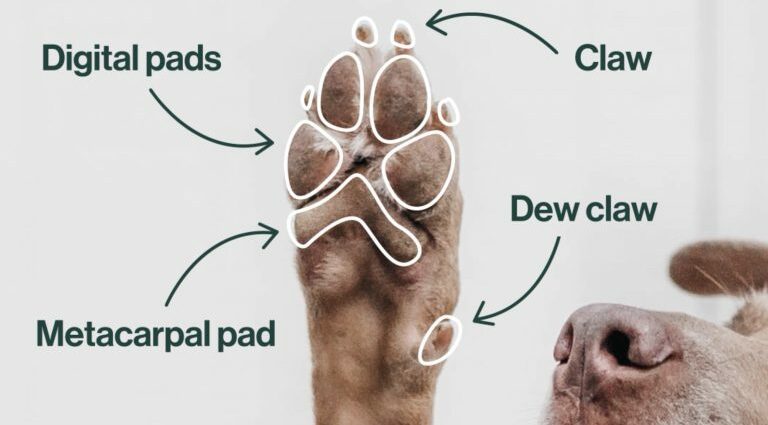Contents
Dog’s paws: how to take care of them?
A damage or injury to a paw of your dog can be painful and disabling. Therefore, taking good care of your dog’s paws and more particularly your dog’s pads is important for his health and well-being. In any case, if you have the slightest doubt, do not hesitate to contact your veterinarian.
Anatomy of dog’s paws
The dog is a so-called digitigrade animal, that is to say it walks on its fingers. The dog’s front legs, or forelegs, are made up of 5 digits:
- 1 first finger on the inside of the leg and which is not in contact with the ground. It is about a rudiment of thumb which one calls ergot. A pad comes to protect this lug;
- 4 fingers in contact with the ground. Each is protected by a digital pad.
The dog’s hind legs, or hind legs, are only made up of the 4 fingers in contact with the ground. The first finger is missing. However, some dog breeds, such as the Beauceron for example, may have a double dewclaw present in each of the hind legs.
Each finger has a nail, or claw, at its end. These nails are continuously growing just like in humans, so it is worth taking care of them, especially if your dog is not using them on his own. On each of the legs, in addition to the 4 finger pads, a metacarpal pad (for the forelegs) or metatarsal (for the hind legs) is also present and in contact with the ground. Finally, there is also a carpal pad, only present on the forelegs, placed higher and which is not in contact with the ground.
The dog’s paws allow it to move on different soils. The pads, composed of a horny layer, are present for the protection of his fingers when moving but also to cling to different surfaces. These pads are therefore thick and become rough over time. They are also made up inside a fatty layer. The pads thus have a damping and insulating role. It is also through the pads, made up of sweat glands, that dogs sweat.
Nail trimming
Made up of keratin like our nails and hair, dog nails grow continuously. Some dogs, especially those with outdoor access, will never need nail trimming because they wear them down enough on their own. For others, especially those who live in apartments, regular trimming may be necessary.
To do this, it is essential to have a nail clipper specially designed for dogs. Indeed, this is necessary for their safety in order to avoid any injury. The dog’s nail is made up of blood vessels contained in what is called the nail matrix. In dogs with light nails, it is easily spotted. This is the pink part that can be seen by transparency of the nail. It is this part that will bleed if the nails are cut too short. It is therefore important to cut only the end where the die is not present.
For dogs with black nails, this matrix is unfortunately not visible. It is therefore recommended to proceed with caution by applying pressure before cutting to see if the dog shows reluctance or not. You can also entrust this task to your veterinarian.
However, if you’ve accidentally cut a nail too short and it’s bleeding, don’t panic. All you need to do is put on a compress and apply pressure on the end of the claw for several minutes. Do not hesitate to get help from another person while the hemostasis (stop bleeding) takes place. Be sure to keep an eye on this nail in the days that follow. If you find that it is painful, infected, or any other abnormal condition, see your veterinarian.
What to do in case of injury ?
Cold
The cold can damage the pads with the appearance of cracks. They do not cause bleeding and are the result of a lack of hydration of the pads. Solutions exist to remedy this. Many moisturizing pad balms are now commercially available. For more information on which balm to use in your dog, do not hesitate to contact your veterinarian. In addition, shoes and socks for dogs exist and may be necessary in the event of repeated exposure to snow.
Burns
The dog’s pads can be burnt in several cases. First in winter, the salt used for snow on the roads can be caustic to the pads that are exposed to it for a long time. In addition, in summer in case of high heat, the pads can burn on contact with surfaces that heat easily, such as bitumen. A consultation with your veterinarian may then be necessary.
Spikelets
The spikelets are small dry ears particularly present in the summer season and which can be lodged in many places of the body of which the interdigitated spaces (spaces between the fingers) of the dogs. With their tip, they penetrate the skin and always advance in a unidirectional manner. Very painful and can be the cause of complications (lameness, abscess, etc.), it is therefore important to check your animal well, in particular if it has long hair, after each walk.
cut
Cuts of the pads frequently occur when the dog walks on glass or sharp objects for example. The dog may then limp and a bleeding cut may be visible. In this case, rinse the wound with clean water and bandage before going to your vet. Depending on the severity, a cut in a pad can be an emergency.
Hyperceratosis
Hyperkeratosis is an inherited disease that affects certain breeds of dogs, such as the Irish Terrier or the Dogue de Bordeaux for example. It can also be present in older dogs. This is a thickening and hardening of the pads that can appear quite early in certain predisposed breeds. This disease can lead to lesions such as crevices or cracks which can be very painful.










